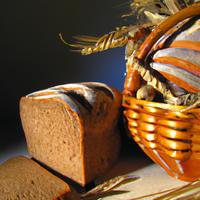
1 serving (43 grams) contains 110 calories, 5.0 grams of protein, 1.5 grams of fat, and 20.0 grams of carbohydrates.

Log this food in SnapCalorie

Nutrition Information
Calories |
611.1 | ||
|---|---|---|---|
% Daily Value* |
|||
| Total Fat | 8.3 g | 10% | |
| Saturated Fat | 1.7 g | 8% | |
| Polyunsaturated Fat | 0 g | ||
| Cholesterol | 0 mg | 0% | |
| Sodium | 944.4 mg | 41% | |
| Total Carbohydrates | 111.1 g | 40% | |
| Dietary Fiber | 16.7 g | 59% | |
| Sugars | 16.7 g | ||
| protein | 27.8 g | 55% | |
| Vitamin D | 0 mcg | 0% | |
| Calcium | 222.2 mg | 17% | |
| Iron | 8.3 mg | 46% | |
| Potassium | 444.4 mg | 9% | |
* Percent Daily Values are based on a 2,000 calorie diet. Your daily values may be higher or lower depending on your calorie needs.
Food Attributes
Source of Calories
About Whole grain wheat bread
Whole Grain Wheat Bread is a wholesome, nutrient-packed staple in many cuisines worldwide, valued for its robust flavor and health benefits. Made primarily from whole wheat flour, water, yeast, and a touch of salt, this bread retains the nutrient-dense kernel of the wheat grain, including fiber, vitamins, minerals, and antioxidants. Its origins trace back to ancient agricultural societies, where whole grains were widely used in traditional bread-making. Whole Grain Wheat Bread is an excellent source of dietary fiber, supporting digestion and heart health while helping to maintain steady energy levels. Additionally, it often contains complex carbohydrates and fewer processed ingredients compared to refined breads. However, some varieties may include added sugars or preservatives, so checking labels is key. Perfect for sandwiches, toast, or a side to soups and stews, its rich texture and earthy taste make it a versatile and nutritious choice for daily meals.



